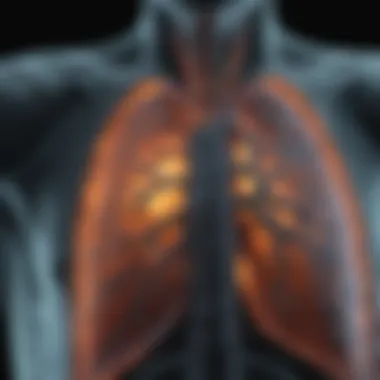Ground Glass Opacity in Lungs: Understanding and Implications


Intro
Ground glass opacity (GGO) in the lungs is a significant radiological finding, which can raise concern for clinicians and patients alike. This opaque appearance on imaging studies, often seen in chest CT scans, suggests alterations in the lung's normal air-filled spaces. Understanding the implications of GGO is crucial for effective diagnosis and management of various respiratory conditions.
Many factors contribute to the development of GGO, including infectious processes, inflammatory conditions, and neoplasms. Therefore, recognizing the causes and potential outcomes associated with GGOs is essential. Various imaging techniques and their interpretation play a pivotal role in identifying the underlying pathologies. As health professionals continue to enhance their understanding of GGOs, newer approaches and treatment strategies emerge, shaping patient management protocols.
Prolusion to Ground Glass Opacity
Ground glass opacity, often referred to as GGO, is a significant finding in radiological assessments of the lungs. Understanding this phenomenon is crucial for clinicians, radiologists, and professionals involved in pulmonary medicine. The interpretation of GGOs can often signal abnormal lung conditions, hence requiring a thorough comprehension of its implications.
In this section, we will delve into the definition of ground glass opacity and examine its relevance in pulmonary health. These insights will set the stage for exploring the mechanisms, causes, and management strategies associated with GGOs in subsequent sections.
Definition of Ground Glass Opacity
Ground glass opacity describes a specific pattern seen on high-resolution computed tomography (HRCT) scans of the lungs. It appears as a hazy region that does not obscure the underlying vascular structures or bronchial markings. This distinct appearance results from partial filling of airspaces, interstitial thickening, or a combination of both. GGOs can vary greatly in size and extent, indicating a spectrum of potential pathologies.
Importance in Pulmonary Health
Ground glass opacities hold significant importance in assessing pulmonary health. Their presence can suggest various underlying conditions ranging from inflammation to malignancy.
- Detection of Early Disease: GGOs may serve as an early indicator of lung disease, prompting further investigation and timely intervention.
- Clinical Implications: The classification and extent of GGOs help in determining the prognosis of certain pulmonary conditions. Early identification can lead to more targeted therapies and better patient outcomes.
- Research Opportunities: The evolving understanding of GGOs presents opportunities for new research, enhancing knowledge about their implications on respiratory health.
GGOs are crucial in the early detection and management of diverse pulmonary diseases. Their interpretation is essential for clinicians aiming to provide informed patient care.
Mechanisms of Ground Glass Opacity Formation
Understanding the mechanisms behind the formation of ground glass opacities (GGOs) is crucial for interpreting their significance in radiology and clinical practice. GGOs represent a state in which the normal pulmonary architecture is obscured but not completely lost. This nuanced understanding can enhance diagnostic accuracy and inform treatment strategies. The causes of GGOs often indicate underlying pathological processes that require careful consideration.
Pathophysiological Factors Involved
The formation of GGOs is linked to various pathophysiological mechanisms. These mechanisms primarily revolve around alterations within the lung parenchyma. When examining these factors, we can identify several key contributors:
- Alveolar Filling: In disease states, like pulmonary edema or infections, fluid or inflammatory cells fill the alveoli, resulting in increased attenuation on imaging. This can create the appearance of GGOs.
- Interstitial Changes: Conditions such as pulmonary fibrosis lead to changes in the lung interstitium. Thickening or scarring can contribute to opacities observed during imaging studies.
- Increased Vascularity: Inflammatory processes can cause an increase in blood flow to certain areas of the lung. This, too, can create regions of ground glass opacity due to the interplay of air and fluid.
These factors reflect both acute and chronic processes in the lungs, making it critical to understand which are relevant in specific clinical scenarios. Knowledge of these underlying mechanisms aids in differentiating between benign and more serious conditions.
The Role of Inflammation
Inflammation plays a central role in the development of ground glass opacities. It acts as a key driver in many infectious and non-infectious lung diseases. The mechanisms include:
- Immune Response: When the lung encounters infection or injury, a robust immune response is triggered. This may cause the release of inflammatory mediators, leading to fluid accumulation.
- Alveolar Cell Damage: Inflammatory processes can damage epithelial cells in the alveoli, promoting fluid leakage and resulting in GGOs.
- Neutrophil Infiltration: In cases of pneumonia, neutrophils flock to the infected sites, causing further inflammation. The consolidation of these cells can contribute to the opacity seen on imaging.
In summary, both the pathophysiological factors and the role of inflammation are fundamental to understanding GGOs. Clinicians can leverage this information to diagnose the underlying conditions associated with GGOs accurately. This layered understanding enhances clinical decisions and ultimately improves patient outcomes.
Common Causes of Ground Glass Opacity
Understanding the common causes of ground glass opacity (GGO) is vital in the assessment and management of lung health. These causes shed light on the array of potential underlying conditions that a patient might present. Recognizing specific causes enables clinicians to tailor diagnostic and therapeutic strategies to the individual needs of the patient, thus optimizing patient outcomes. This section discusses infectious diseases, interstitial lung diseases, and other contributing factors to GGO.


Infectious Diseases
Viral Infections
Viral infections are among the leading causes of ground glass opacities in the lungs. Understanding the role of viruses, such as SARS-CoV-2, can provide significant insights into respiratory illnesses. The key characteristic of viral infections is their ability to cause diffuse pulmonary involvement, leading to the speckled appearance noted on imaging. This specificity makes them particularly relevant given the ongoing changes in global health dynamics. One unique aspect of viral infections is their capacity for rapid transmission and the resultant acute lung injury, highlighting the need for prompt identification and management in clinical settings.
Bacterial Infections
Bacterial infections also present a considerable contribution to the presence of ground glass opacities. Conditions like pneumonia and tuberculosis can manifest as GGOs. A key characteristic of bacterial infections is that they may lead to localized infiltrates, which can sometimes resemble the diffuse patterns seen in viral infections. This ambiguity necessitates a careful diagnostic approach. A unique feature of bacterial infections is the potential for secondary complications like abscess formation, emphasizing the importance of recognizing them early in the treatment process. Treatment can be straightforward with antibiotics, but resistance is a growing concern that complicates management strategies.
Fungal Infections
Fungal infections, while less common, can also result in ground glass opacities. Diseases such as aspergillosis are significant contributors to pulmonary GGO patterns. The key characteristic of fungal infections is the granulomatous response they elicit in lung tissue. They are a relevant choice for this article due to their increasing incidence, especially in immunocompromised patients. One notable aspect is the often protracted course of illness associated with fungal infections, which can lead to chronic lung disease if not addressed timely. The challenges in diagnosing these conditions can prolong appropriate treatment, which complicates patient outcomes considerably.
Interstitial Lung Diseases
Idiopathic Pulmonary Fibrosis
Idiopathic pulmonary fibrosis (IPF) is another critical condition associated with ground glass opacities. The key characteristic of IPF is that it typically presents progressive fibrosis in lung tissue, impacting gas exchange. Its relevance in this article cannot be overstated, as it serves as a prime example of how GGO can indicate serious underlying pathology—leading to a decline in lung function over time. The unique feature of IPF is its unpredictable progression, which poses challenges for management; some patients may respond well to antifibrotic therapies while others may not.
Sarcoidosis
Sarcoidosis is characterized by the presence of granulomas in multiple organs, including the lungs, and often leads to GGOs on imaging studies. Its key characteristic is that it may have either asymptomatic or symptomatic presentations, thus affecting patient management strategies. The significance of sarcoidosis in this article lies in its variable course, which can lead to both acute and chronic manifestations. This variability requires careful consideration in diagnosis and treatment, as the response to therapy can differ widely among patients.
Other Contributing Factors
Pulmonary Edema
Pulmonary edema is significant in discussing the common causes of GGO. This condition typically arises from heart failure but can also result from other conditions leading to fluid accumulation in the alveolar spaces. Its key characteristic is the rapid development of respiratory symptoms accompanied by ground glass opacities on imaging. It becomes essential to note that while pulmonary edema can be manageable with diuretics and supportive care, improper management may pose risks like respiratory failure.
Hemorrhage
Lastly, hemorrhage within the lungs can generate ground glass opacities. Conditions leading to pulmonary bleeding such as pulmonary hemorrhage syndromes or traumatic events can cause GGOs on imaging. The key characteristic is that the opacity reflects a mixture of blood and inflammatory material in the air spaces. The contribution of hemorrhage to GGO is crucial to recognize, as it necessitates immediate intervention depending on the underlying cause. It presents distinct diagnostic challenges, often requiring a multidisciplinary approach for effective management.
Understanding these causes of ground glass opacity is paramount in advancing patient care. Proper identification leads to targeted interventions tailored to individual illnesses.
Diagnostic Imaging Techniques
Diagnostic imaging techniques play a crucial role in the evaluation of ground glass opacity (GGO) in the lungs. These methods are essential for identifying and characterizing lung pathologies associated with GGO. The correct application of these techniques can assist healthcare professionals in making informed decisions, which is a significant factor in patient outcomes.
Among the various imaging modalities available, high-resolution computed tomography (HRCT) stands out as the preferred technique for assessing GGOs. This approach allows for detailed visualization of lung anatomy and provides important diagnostic information. Radiologists and clinicians benefit from HRCT's capability to capture fine details, which is especially useful in differentiating between various causes of lung opacity.
Moreover, the interpretive capacity in imaging affects clinical management. Radiological findings must be carefully interpreted in the context of the patient's clinical picture. This means considering patients' symptoms, history, and any laboratory findings alongside the imaging results. Keeping a multidisciplinary approach enhances the accuracy of diagnosis and treatment planning.
High-Resolution Computed Tomography (HRCT)
High-resolution computed tomography is an advanced imaging technique that produces high-quality images of the lungs with greater detail than standard CT scans. The utility of HRCT in detecting ground glass opacities cannot be overstated. It allows for the differentiation of various types of opacity, which can indicate different pathological entities.
HRCT is particularly adept at revealing subtle changes in lung parenchyma which other imaging methods may miss. This feature is vital for identifying early-stage lung diseases. Common parameters evaluated in HRCT include the extent, distribution, and type of GGO. These factors guide further diagnostic and therapeutic decisions.


Additionally, patients undergoing HRCT may experience less radiation exposure due to the advancements in imaging technology. This safety aspect is increasingly important, especially in long-term monitoring of lung conditions.
Interpreting Radiological Findings
Interpreting radiological findings requires expertise and a meticulous approach. The identification of ground glass opacity in lung imaging is not merely about recognition; it entails correlating these findings with clinical symptoms and history. Radiologists often categorize GGOs based on appearance, pattern, and accompanying signs such as consolidation or reticular patterns.
Understanding the clinical context is essential. For instance, a widespread GGO in a patient with flu-like symptoms may indicate viral pneumonia. In contrast, localized GGO alongside fibrosis may suggest a chronic condition, such as idiopathic pulmonary fibrosis.
Some key considerations include:
- Temporal Changes: Monitoring the evolution of GGOs over time can provide insights into the underlying pathology.
- Distribution: The pattern of GGO can signify different diseases. Diffuse GGOs may relate to interstitial lung diseases, while peripheral GGOs may indicate infectious processes.
- Accompanying Findings: Identifying associated features helps refine diagnosis. This includes looking for signs of interstitial thickening or air trapping.
"In the realm of diagnostic imaging, a comprehensive understanding of radiological findings is vital for ensuring accurate diagnosis and effective management of health concerns."
Accurate interpretation of imaging studies stands as a cornerstone in the patient's diagnostic pathway. Failing to recognize subtle changes can lead to misdiagnosis, which may subsequently result in inadequate treatment strategies. Thus, the reliance on both comprehensive imaging techniques and robust clinical interpretation cannot be overstated.
Clinical Significance of Ground Glass Opacity
Ground glass opacity (GGO) in the lungs is not merely a radiological finding; it represents a significant marker for various pulmonary conditions. Understanding the clinical significance of GGOs is essential for accurate diagnosis and effective management of respiratory diseases. Acknowledging their presence can lead to early interventions, potentially influencing patient outcomes. This section highlights why GGOs matter in the context of lung health, outlining their prognostic implications and the potential for disease progression that clinicians and patients must consider.
Prognostic Implications
The identification of ground glass opacities in diagnostic imaging offers critical insights into the underlying pathology affecting the lungs. GGOs can be associated with numerous conditions, ranging from benign issues like pulmonary infections to more severe diseases such as interstitial lung disease and even malignancies.
- Indicator of Disease Severity: GGOs can signify the extent of lung involvement in various diseases. For instance, a larger extent of GGO often correlates with worsened lung function, framing the prognosis in more serious terms for the patient.
- Assessment of Treatment Response: Changes in GGOs over time can indicate how well a patient is responding to treatment. A reduction in opacity might suggest effective management of the underlying condition, aiding in decision-making about ongoing therapy.
- Surveillance for Complications: Monitoring the development or changes in GGOs can provide vital clues about the progression of diseases, alerting healthcare providers to complications such as fibrosis, which could drastically alter the treatment landscape.
"One must view GGOs as not just a radiological anomaly, but as a crucial component in the diagnostic puzzle of pulmonary ailments."
In essence, the prognostic implications of GGOs extend beyond the immediate finding. Timely recognition and interpretation can steer the clinical approach towards more personalized patient care.
Potential for Disease Progression
GGOs can also indicate potential for disease progression, often prompting further investigation to understand the full clinical picture. The evolution of ground glass opacities may highlight pre-existing conditions that may not be readily apparent during initial assessments. Consider these factors:
- Predisposition to Fibrosis: Persistent GGOs can evolve into denser opacities, suggesting progression toward fibrosis, which remains a major concern for patients with interstitial lung disease.
- Indication of Malignancy: In some cases, the presence of GGOs can raise suspicion of malignancies, demanding vigilant follow-up and possible biopsy to rule out cancerous processes.
- Impact on Quality of Life: Understanding the potential for disease progression is essential for setting realistic expectations and treatment goals. A patient with progressive disease may experience worsening respiratory function and corresponding changes in their lifestyle.
Overall, the potential for disease progression associated with GGOs should not be underestimated. As more studies arrive, the relationship between GGOs and patient outcomes becomes clearer, highlighting the need for ongoing research in this area.
Management Strategies for Ground Glass Opacity
Management strategies for ground glass opacity (GGO) are crucial in optimizing patient outcomes and addressing the underlying conditions contributing to this radiological finding. Effective management requires an approach tailored to the specific cause of GGO, informed by comprehensive diagnostics. Proper understanding of the management practices can significantly enhance patient care and facilitate better prognostic outcomes. This section explores various treatment options and monitoring protocols essential for managing GGO effectively.
Treatment Options Based on Underlying Cause
Ground glass opacities can arise from numerous conditions, necessitating different treatment strategies depending on the underlying etiology. Identifying the specific cause is the cornerstone of any management plan. Treatment may involve:
- Infectious Causes: For viral pneumonia, supportive care is often sufficient, while bacterial infections may require antibiotics such as azithromycin or doxycycline. Antifungal medications might be necessary for fungal infections like aspergillosis.
- Interstitial Lung Diseases: Conditions like idiopathic pulmonary fibrosis may benefit from antifibrotic agents, including pirfenidone or nintedanib. Meanwhile, sarcoidosis may require corticosteroids to manage inflammation.


Treatment must always be guided by careful evaluation of the patient's overall health and specific circumstances surrounding their condition.
- Pulmonary Edema: The management of pulmonary edema might include diuretics like furosemide to reduce fluid overload and enhance gas exchange efficiency.
- Hemorrhage: In cases of hemorrhage, addressing coagulation abnormalities may be critical. This may involve medications to correct clotting factors or procedures to remove significant blood accumulations.
Each treatment option has distinct implications for patient care, from the potential for recovery to the risk of complications. A multidisciplinary team often collaborates to ensure optimal outcomes.
Monitoring and Follow-Up Protocols
Once GGO management begins, systematic monitoring plays an important role in assessing treatment efficacy and detecting potential complications. Considerations for follow-up protocols include:
- Regular Imaging: Follow-up chest imaging, primarily through high-resolution computed tomography (HRCT), allows for continuous assessment of GGO evolution. Regular scans can help in identifying any changes that may indicate disease progression or improvement.
- Clinical Evaluations: Frequent clinical assessments are essential. Evaluation of symptoms, respiratory function, and overall health status provides insights into the patient’s response to treatment.
- Laboratory Tests: Routine laboratory testing can help monitor possible side effects of treatments, particularly in cases requiring long-term medication.
- Multidisciplinary Review: Regular meetings among specialists, such as pulmonologists, radiologists, and pathologists, foster collaboration and ensure all aspects of the patient’s care are considered.
Employing these monitoring strategies ensures that care is dynamic and responsive to patient needs, ultimately improving outcomes for those with ground glass opacities.
Emerging Research on Ground Glass Opacity
Emerging research on ground glass opacity (GGO) is central to enhancing our understanding and management of this significant radiological finding. Recent studies focus on advanced imaging techniques, histopathological correlation, and the molecular mechanisms involved in ground glass opacities. The implications of these findings are profound, influencing both clinical practices and future research trajectories.
Recent Advances in Understanding GGOs
Recent advancements in the analysis of GGOs have improved diagnostic accuracy. Research often emphasizes the role of high-resolution computed tomography (HRCT) in revealing subtle patterns that may indicate specific underlying conditions.
- Clinical Trials: New clinical trials examine the predictive value of GGO patterns in patients. These studies assess how specific characteristics, such as changes in density and extent of opacity, correlate to disease progression.
- Immunological Insights: Understanding the immunological aspects of GGOs is also gaining traction. Researchers investigate how chronic inflammation and immune responses lead to the development of GGOs, especially in cases of interstitial lung diseases.
“Identifying the exact relationship between GGO patterns and various lung diseases allows for targeted interventions and better patient management.”
Moreover, genetic studies are unveiling potential hereditary components that may predispose individuals to conditions associated with GGOs. Increased understanding of these genetic factors could improve risk assessment strategies going forward.
Novel Therapeutic Approaches
The landscape of treatment options for GGOs is evolving, thanks to emerging research. Novel therapies aim to address the underlying conditions causing GGOs rather than merely mitigating symptoms.
- Targeted Therapies: There are promising developments in targeted therapies for specific conditions linked to GGOs, such as idiopathic pulmonary fibrosis and certain types of lung cancer. These therapies focus on modulating immune responses or inhibiting specific tumor growth pathways.
- Combination Treatment Protocols: Researchers are also exploring combination protocols that integrate traditional therapies with novel agents, producing synergistic effects. For instance, combining corticosteroids with antifibrotics may prove beneficial in reducing inflammation while preventing fibrosis.
Engagement with multicenter trials can further validate these findings, solidifying new treatment paradigms. As research progresses, these approaches might transform how clinicians manage GGOs and improve patient outcomes, making emerging research critical in the setting of respiratory health.
Closure
The conclusion serves as a vital component of this article, offering a detailed encapsulation of the discussions surrounding ground glass opacity (GGO) in the lungs. Ground glass opacity is not simply a radiological term; it embodies critical insights into a patient's pulmonary health. Understanding the implications of GGO can lead to improved diagnostic and treatment strategies, ultimately enhancing patient care.
In summarizing the key insights, one must highlight how GGO can signify various underlying conditions. It acts as a window into the lungs, revealing patterns that may necessitate further investigation. This exploration is essential as it links the diagnostic imaging findings to potential clinical outcomes. A focus on emerging research further underscores the importance of GGO in advancing medical practice.
Summary of Key Insights
- Definition and Importance: GGO refers to a specific radiological finding that represents abnormal lung activity. Recognizing its significance helps in early diagnosis of various pulmonary diseases.
- Diverse Underlying Causes: The article examines multiple causes leading to GGO, emphasizing that it can stem from infections, interstitial lung disease, and more.
- Diagnostic Tools: The significance of high-resolution computed tomography (HRCT) is paramount. This tool plays a crucial role in visualizing GGO, aiding in more accurate assessments.
- Clinical Relevance: Ground glass opacities have prognostic implications that cannot be overlooked. Their presence may indicate disease progression and warrant close monitoring.
- Emerging Research: Continuous studies in the field highlight innovative approaches to managing GGO, indicating a dynamic shift towards enhanced therapeutic strategies.
Future Directions in Research and Treatment
Navigating the future of research and treatment in relation to GGO opens several avenues worth exploring. Growing advancements in imaging technology promise to refine diagnostic accuracy. The integration of artificial intelligence in radiology may further streamline the interpretation of GGO, reducing the burden on healthcare professionals.
Moreover, deeper investigations into the pathophysiological mechanisms underlying GGO can unveil targeted therapies. Personalized medicine approaches may emerge, where treatments are tailored based on the specific causes of the ground glass opacity observed.
Innovative therapeutic interventions, particularly those focusing on inflammation, will also likely gain traction. This shift is crucial as managing underlying inflammatory processes could mitigate the impact of GGO on lung function.
In summation, ongoing research and advancements in medical technology present an optimistic outlook for understanding and managing ground glass opacities. As knowledge evolves, it will surely influence the standard of care for patients presenting with this important radiological finding.







